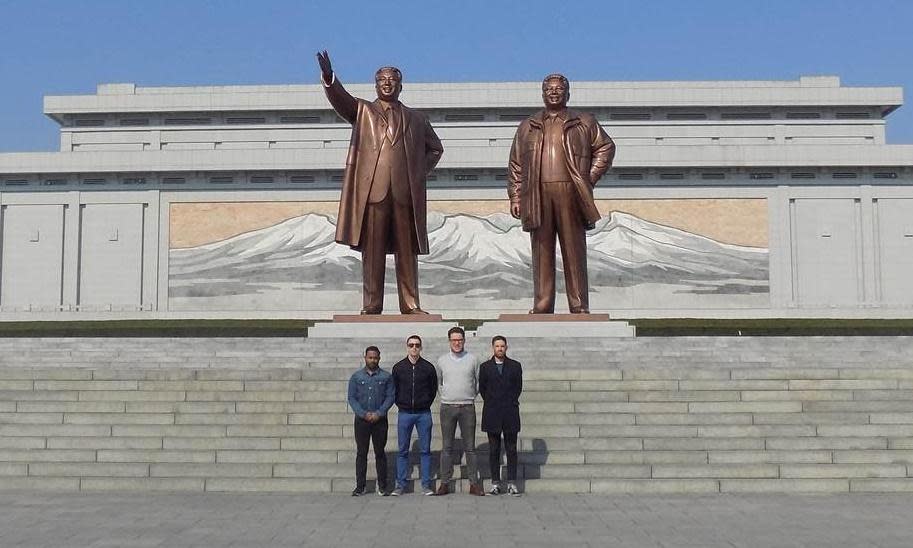North Korea is reopening to tourists after almost five years, but will anyone go?

North Korea is to welcome back international tourists at the end of the year, according to travel agencies, but experts have warned that the long-awaited opening up could fall victim to political tensions and the country’s brutal winters.
The North sealed its borders and banned international visitors soon after the Covid-19 pandemic took hold in early 2020, fearing the virus could cripple its already fragile health services. The closure hit trade with China and denied the regime tourist dollars, while its leader, Kim Jong-un, reportedly sheltered at his coastal holiday home.
Although international flights in and out of North Korea resumed last year, and about 100 Russian tourists took part in a private tour in February, the country essentially remains closed to outsiders.
Related: How North Korea’s lucrative trade in human hair is helping it skirt the impact of sanctions
The apparent decision to lower the drawbridge has been welcomed by tour companies, but some North Korea watchers say plans to resume tourism after almost five years of pandemic-enforced isolation are fraught with problems.
North Korean state media have yet to comment on the reported opening up, although Kim has taken a personal interest in developing the tourism infrastructure and spoken of his desire to welcome visitors from “friendly” nations, China and Russia.
The official motivation has changed little since the North banned foreign tourists in 2020 – namely, to showcase a modern, content country centred on unwavering public devotion to three generations of the Kim dynasty.
The first visitors are expected to be confined to Samjiyon, a city near the Chinese border, described by North Korea as a “socialist utopia” and “a model of highly civilised mountain city”.
The destination, which reportedly boasts new apartments, hotels and a ski resort, is a gateway to Mount Paektu, the highest peak on the peninsula and considered the mythical birthplace of a united Korean people – a place of pilgrimage that supports the cult of personality surrounding the family that has ruled with an iron fist since the country’s foundation in 1948.
Koryo Tours, which was forced to put visits on hold at the start of the pandemic, welcomed the reported resumption of tourism, adding that the move would probably extend to the rest of the country.
“Having waited for over four years to make this announcement, Koryo Tours is very excited for the opening of North Korean tourism once again,” the Beijing-based firm said on its website, adding that its local partner would confirm itineraries and dates in coming weeks.
A second travel agency, Shenyang-based KTG Tours, also announced that tourists would be able to visit Samjiyon from this winter.
But some experts said the plans could fall foul of the harsh weather that grips the remote Samjiyon area in winter, along with poor local infrastructure and, for Westerners, a reluctance to travel to a country that has become more aggressive in recent years.
“I can’t see how … Samjiyon, being one of the more isolated tourist destinations within the DPRK, would be the first for the Koreans to try and open for the broader tourism market,” Rowan Beard, the manager of Young Pioneer Tours, told the NK News website, using the country’s official name the Democratic People’s Republic of Korea.
Travel industry officials said they expected the first wave of tourism to be dominated by Chinese nationals and, in light of Kim’s recent meetings with Vladimir Putin, people from Russia.
“I suspect that the powers that be in Pyongyang believe it’s time to open the borders like all other ‘normal’ nations have since the pandemic ended,” said Prof Dean J Ouellette, an expert in North Korean tourism at the Institute for Far Eastern Studies at Kyungnam University.
“That means opening up to international tourists, whether or not many decide to go, or are allowed by their governments to visit, or are even allowed entry by North Korean authorities because of their nationality.”
China is by far the most important market, with Chinese nationals making up about 90% of tourists to North Korea before Covid-19. Experts say a record 300,000 foreign tourists visited North Korea in 2019, earning the country between $90m and $150m, experts say.
While the North is far from dependent on tourism for foreign currency, the injection of cash could boost its coffers. “If there is a return to the heyday of Chinese tourist arrivals … North Korea could possibly earn an $100m to $175m,” Ouellette said. “For a heavily sanctioned and self-isolating economy like North Korea, that is not an insignificant amount.”
But Chinese leaders have voiced reservations about North Korea’s supply of weapons to Russian forces in Ukraine and are cautiously following Kim’s closer relationship with Putin. “I don’t think we will see a return to those high tourist numbers until Pyongyang repairs relations with Beijing,” Ouellette said.
Tourism to the North was strictly limited before the pandemic, with tour companies saying about 5,000 western tourists visited each year. Americans made up about 20% percent of the market before the US banned its citizens from going there as tourists after the 2017 death of the university student Otto Warmbier.
Cockerell said much had yet to be decided about itineraries, but that tourists would continue to be closely watched. “The main system remains unchanged, with guided tours only and no free movement without guides,” he said. “So when the main part of the country opens up, it may well be the same kind of experience as before.
“I would caution against over-interpreting this opening. It’s not necessarily a message to the world or anything like that … just a slow and small initial opening to restabilise an industry that had already existed for decades.”


